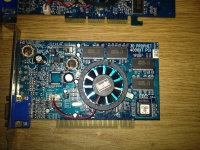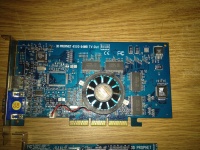Difference between revisions of "PowerVR"
(→Kyro 1) |
|||
| Line 31: | Line 31: | ||
[[File:3D_Prophet_4000XT_PCI.jpg|200px|thumb||3D Prophet 4000XT]] | [[File:3D_Prophet_4000XT_PCI.jpg|200px|thumb||3D Prophet 4000XT]] | ||
| + | The original Kyro was released in 2000 and dropped support for the PowerVR SGL and SGL2 APIs. Its low core and memory clock frequencies and lack of hardware T&L support crippled its performance against its main competitors (namely the GeForce2 MX), but thanks to its tile-based deferred rendering architecture it performed fine in games that had a lot of overdraw. Although it lacked hardware T&L it was still fairly feature rich, with environment-mapped bump mapping (EMBM), ordered-grid super-sampling anti-aliasing and anisotropic filtering (up to level 2x) support. While its anisotropic filtering quality was on par with that of the GeForce 256 / GeForce 2 series, it incurred a very large performance decrease when enabled. | ||
=== Kyro 2 === | === Kyro 2 === | ||
Revision as of 13:44, 27 April 2013
Contents
Series 1
Midas
OEM
PCX-1
PCX-2
1997 and it's bilinear filtered and MiniGL drivers for this are in the 1.0.x.x version range. Supports Direct3D 3, and its own API, SGL.
A seal swimming quickly in polluted water in a sinus pattern was used to demonstrate this card. Bundled games typically are Ultim@te Race.
Something about infinite planes and dummied-out 24-bit rendering.
Something about Crime Cities' MiniGL driver to get newer games ""working""
Series 2
PowerVR SG
Announced early 1998 and never released, however some games were tooled to support it (Half-Life) which suggests a prototypical existence in 1998.
MiniGL drivers for this are in the 1.1.x.x version range.
Neon250
Released in late 1999, something about dreamcast, "still" no support for OpenGL, supports SGL2 API which almost no games used, and it's rare!!!
MiniGL drivers for this are in the 1.2.x.x version range.
Series 3
Kyro 1
The original Kyro was released in 2000 and dropped support for the PowerVR SGL and SGL2 APIs. Its low core and memory clock frequencies and lack of hardware T&L support crippled its performance against its main competitors (namely the GeForce2 MX), but thanks to its tile-based deferred rendering architecture it performed fine in games that had a lot of overdraw. Although it lacked hardware T&L it was still fairly feature rich, with environment-mapped bump mapping (EMBM), ordered-grid super-sampling anti-aliasing and anisotropic filtering (up to level 2x) support. While its anisotropic filtering quality was on par with that of the GeForce 256 / GeForce 2 series, it incurred a very large performance decrease when enabled.
Kyro 2
2001. Another 'false DirectX7' card that supports DirectX 6 features, with S3TC and EMBM. Like everything that isn't Nvidia and ATI, it deprecated quickly for its lack of hardware T&L and its lateness to the market. Most of the marketing were about features the older series had, including tiled rendering, full sorting, internal true color rendering, etc. The emphasis on hidden surface removal was supposed to be the feature to make up for the lack of HW T&L. It also does not support cubemapping.
The tiled rendering was also a drawback to supporting more modern graphic features that rely on rendering-to-texture and framebuffers.
Unsurprising for it's KYRO name (Cairo, Egypt), many tech demos to showcase this card take place in ancient Egypt.
It has no support for the SGL or SGL2 API.

